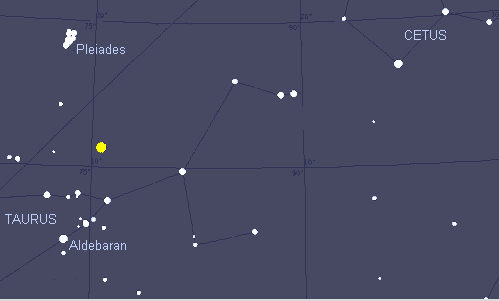Moon dogs - New Mexico
Moon Dogs - A Mesmerizing Atmospheric Phenomenon in New Mexico
Have you ever looked up at the night sky and witnessed a celestial spectacle that left you in awe? One such phenomenon that can captivate observers is the appearance of moon dogs, also known as paraselenae. These enchanting optical effects occur when the Moon's light interacts with ice crystals suspended in the Earth's atmosphere. While moon dogs can be observed in various locations around the world, one particularly breathtaking display was documented in New Mexico.
The Magnificent Moondog Display in Socorro, New Mexico
On November 2, 2001, Walter Brisken, an avid sky watcher, witnessed a mesmerizing moondog display in Socorro, New Mexico. This extraordinary event took place between 19:30 and 20:00 local time. Brisken's stunning photograph captured the moon dog alongside the Moon, the bright star Aldebaran in Taurus just below it, and the ethereal Pleiades star cluster above.
Understanding the Science Behind Moon Dogs
Moon dogs, scientifically referred to as paraselenae, are part of a larger family of atmospheric optical phenomena called halos. These captivating displays occur when light from the Moon or the Sun is refracted, or bent, by ice crystals in the atmosphere. The ice crystals act as tiny prisms, causing the light to split into its component colors and creating a variety of optical effects.
Ice Crystals and Moon Dogs
To understand why New Mexico's atmospheric conditions were favorable for such a remarkable moon dog display, we need to delve into the specifics of ice crystal formation. In this instance, wispy cirrus clouds provided the canvas for the interaction between the Moon's light and the ice crystals. These high-altitude clouds consist of tiny ice particles that are shaped like hexagonal plates or columns. As moonlight passes through these hexagonal crystals, it is refracted and separated into a range of colors, resulting in the awe-inspiring moon dog effect.
The Appearance of Moon Dogs
Moon dogs appear as bright spots of light on either side of the Moon, forming a halo-like circle around it. They are most commonly observed when the Moon is near its full phase, as the increased brightness enhances the visibility of these ethereal companions. Moon dogs can vary in intensity, ranging from subtle and faint to vivid and pronounced. The size and shape of the ice crystals, as well as their orientation in the atmosphere, influence the appearance of these captivating optical phenomena.
The Enchanting Company of Aldebaran and the Pleiades
During the Socorro moondog event, Walter Brisken's photograph showcased the presence of Aldebaran, a bright star in the constellation Taurus, situated just below the Moon. Aldebaran's proximity added an extra layer of celestial beauty to the already enchanting scene. Moreover, the photograph also captured the Pleiades star cluster above the Moon. The Pleiades, also known as the Seven Sisters, is a renowned group of stars that has fascinated stargazers throughout history. The inclusion of Aldebaran and the Pleiades in the composition added depth and intrigue to the visual spectacle.
Captivating Moon Dogs Around the World
While the Socorro moondog display was undoubtedly captivating, moon dogs can be observed in various locations worldwide. These atmospheric phenomena have been documented in different regions and under diverse atmospheric conditions. Each sighting offers a unique and awe-inspiring experience, showcasing the beauty and complexity of our planet's atmosphere.
The Magic of Atmospheric Optics
The occurrence of moon dogs serves as a reminder of the magic and wonder that can be found in the natural world. Atmospheric optics presents us with a window into the intricate workings of light and matter, transforming our skies into canvases of ethereal beauty. Whether it be the enchanting moon dogs of New Mexico or the myriad of other optical phenomena that grace our atmosphere, these spectacles remind us of the immense complexity and beauty that surrounds us.
So, the next time you find yourself gazing up at the night sky, take a moment to appreciate the celestial wonders above. You never know when you might witness a breathtaking display of moon dogs or other atmospheric marvels that will leave you in awe of the world we inhabit.

Paraselene in wispy cirrus. The Moon had recently risen when Walter Brisken saw this moondog at 1930 - 2000 on November 2, 2001 at Socorro, New Mexico. The bright star below the Moon is Aldebaran in Taurus and the Pleiades are above. ©Walter Brisken, reproduced with permission.

Note: this article has been automatically converted from the old site and may not appear as intended. You can find the original article here.
Reference Atmospheric Optics
If you use any of the definitions, information, or data presented on Atmospheric Optics, please copy the link or reference below to properly credit us as the reference source. Thank you!
-
<a href="https://atoptics.co.uk/blog/moon-dogs-new-mexico/">Moon dogs - New Mexico</a>
-
"Moon dogs - New Mexico". Atmospheric Optics. Accessed on April 27, 2024. https://atoptics.co.uk/blog/moon-dogs-new-mexico/.
-
"Moon dogs - New Mexico". Atmospheric Optics, https://atoptics.co.uk/blog/moon-dogs-new-mexico/. Accessed 27 April, 2024
-
Moon dogs - New Mexico. Atmospheric Optics. Retrieved from https://atoptics.co.uk/blog/moon-dogs-new-mexico/.